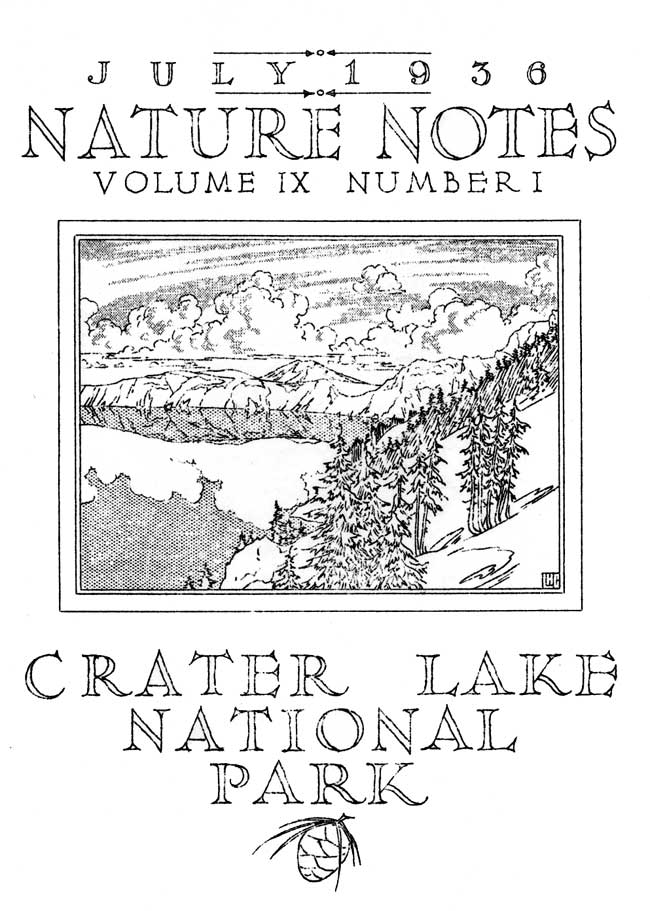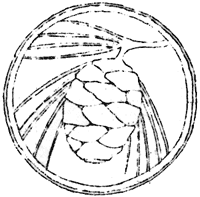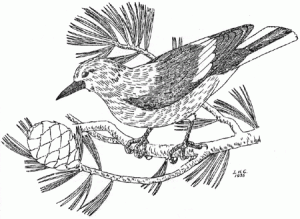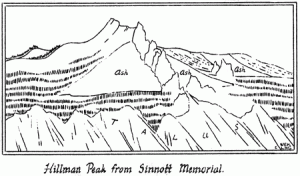
Volume 9 No. 1 – July 1, 1936All material courtesy of the National Park Service. These publications can also be found at http://npshistory.com/Nature Notes is produced by the National Park Service. © 1936. |
Nature Notes from Crater Lake National Park, prepared by the naturalist staff during the summer months, will from time to time include articles on the natural features of Crater Lake National Park as well as on the features of the Lava Beds National Monument and the Oregon Caves National Monument, both of the monuments being under the administration of the superintendent and staff of Crater Lake National Park.
The Lava Beds National Monument, in northeastern California, includes an area of approximately 45,000 acres. As the name suggests, the monument contains outstanding volcanic formations, some of which are of quite recent origin. There are hundreds of subterranean channels or tubes which were once the passageways for streams of molten lava. Numerous symmetrical cinder cones, locally known as “buttes”, rise several hundred feet above the general level of the adjacent country. There are excellent examples of quite recent “aa” and “pahoehoe” lava flows. The Lava Beds National Monument is also interesting from a historical standpoint. The area includes the battlefields of the famous Modoc War of 1872-1873. The area also includes important ethnological and archeological features. Petroglyphs and pictographs on cliffs and in caves are evidence that the region was inhabited by primitive people long before the coming of white man.
The Oregon Caves National Monument is located in the heart of the Siskiyou Mountains in southwestern Oregon. It was established as a national monument in 1909, under the Department of Agriculture. An Executive Order transferred the monument to the jurisdiction of the National Park Service in 1934, the superintendent of Crater Lake National Park being administrative head of the monument.
The caves, named “The Marble Halls of Oregon” by Joaquin Miller, the Poet of the Sierra, are truly marble halls. Underground water penetrating to great depth along fractures in the marble formation has dissolved out an extensive system of chambers. Water, dripping from the ceilings and walls, has decorated the halls and passageways with fantastic stalactites and stalagmites which stimulate ones imagination as well as ones appreciation of the beauties of nature existing in caverns never touched by sunlight.
Clark’s Nutcrackers Banded for Study
By Chas. W. Quaintance, Ranger-Naturalist
Although some eighty species of birds have been recorded in Crater Lake National Park, relatively little is known about how they live. This is the condition of zoology in general; however, in recent years students of zoology have studied animals in their natural state. The results of such studies may be of practical value, and too, they may serve to broaden our mental horizons, and provide a background for our knowledge of animal behavior.
Some of the facts of natural history to be ascertained by studying animals in their natural state may be listed. Mating activities vary, even in related species of animals. It is desirable to know something of the nesting habits, the time of year when the young are born, whether the parents mate for life, and other related information. It is of interest to know what animals eat throughout the year, and whether their food habits have any economic bearing. Other activities and facts to be learned are those concerned with their daily and seasonal movements, including migrations. Information on their voice, mannerisms, and the age that animals normally attain is of value.
One animal chosen for study in Crater Lake National Park is a bird, the most conspicuous one in the rim area, one which is associated in the minds of visitors with the Golden-mantled Ground Squirrels. This bird, Nucifraga columbiana, called variously, Clark’s Nutcracker, Clark’s Crow, Clark’s Jay, and though confused with the Gray Jay, “Camp Robber”, is a member of the crow family. It is named after Captain William Clark, of Lewis and Clark fame, who collected in Idaho the first specimens known to science. The bird is unmistakable in its sharply contrasting coat of gray, black and white.
In this study, observations were made at close range and at a distance, using field glasses. Catching the birds for banding was somewhat of a problem. After experimenting unsuccessfully with government sparrow traps and with figure four traps, it was found that a large hood made of one-inch mesh chicken wire would get the birds fairly easily. Peanuts were used for bait. The chief trouble was that of keeping the Golden-mantled Ground Squirrels away until Nutcrackers got the bait.
Sixteen Nutcrackers were banded, each with an aluminum band of the United States Biological Survey and with three molded celluloid bands. The aluminum band is numbered so that the capture of any bird may ultimately be recorded in the Washington Office of the Biological Survey. The three celluloid bands on each of the sixteen birds were selected from a choice of four colors: pink, blue, yellow and red. With three, colored celluloid bands and one aluminum band to a bird, a large number of banding combinations were possible. The weight of the four bands is estimated to be to the bird what a wrist watch is to a man. These markers do not seem to interfere in any way with the progress of the birds. The fact that they came back to the banding station and the trap indicates that they have no unpleasant association with the experience of being banded. Often after being released (from banding) the birds attempted to peck off the ornaments; however, in a short while they became accustomed to the bands. They will wear the bands for years without any ill effects. The table on page 7 of this issue of Nature Notes gives the banding record of the sixteen Clark’s Nutcrackers and one Oregon Jay banded in Crater Lake National Park during the summer of 1936.
Although the results from a study of this kind are not always immediate, at least one fact is already apparent. At the head of the Lake Trail, the birds which have been banded have been recorded from time to time at this same place, and still more come there which are unbanded. This enables one to say with certainty that although only about four birds appear at a time, a great many different individuals actually visit this place during a day.
Other information will come out of this study, and it will be especially interesting if during the winter, observations of the banded birds are reported to the park staff.
| Banding Record – Clark’s Nutcracker | |||||
| Biological Survey Band No. |
Date of Banding (1936) |
Arrangement of Bands | |||
| Left Leg Up |
Left Leg Low |
Right Leg Up |
Right Leg Low |
||
| C 301051 | July 24 | R | R | R | X |
| C 301053 | July 24 | B | B | B | X |
| C 301054 | July 24 | Y | Y | Y | X |
| C 301055 | July 24 | P | P | P | X |
| C 301056 | July 24 | R | P | B | X |
| C 301057 | July 24 | B | Y | – | X |
| C 301058 | July 25 | R | R | B | X |
| C 301059 | July 25 | P | P | B | X |
| C 301060 | July 25 | Y | Y | B | X |
| C 301061 | July 25 | B | B | R | X |
| C 301062 | July 30 | Y | Y | R | X |
| C 301063 | July 30 | Y | Y | P | X |
| C 301064 | July 27 | P | P | Y | X |
| C 301065 | July 30 | R | B | R | X |
| C 301066 | August 3 | P | B | P | X |
| C 301067 | August 3 | P | R | P | X |
| C 301068 | August 3 | Y | R | X | Y |
| R-red B-blue Y-yellow X-Biological Survey | |||||
| Banding Record – Oregon Jay | |||||
| C 301052 | July 14 | Left Leg B | Right Leg X | ||
Some Plants Common to Crater Lake National Park and the Lava Beds National Monument
By Elmer I. Applegate, Ranger Naturalist
A certain group of plants of wide geographic range are of particular interest because they are common to low arid regions and high mountain areas but not common at middle elevations. The presence of these species at the extremes in altitudinal distribution would seem at first thought, to be inconsistent with the laws governing zonal distribution. However, a consideration of the environmental and adaptive factors appears to account for the unusual zonal positions.
Under the conditions of a clear and dry atmosphere, radiation takes place more rapidly, causing a corresponding lowering of the temperature at sunset. In this respect it has been found that arid plains and desert regions are identical with the exposed open slopes of the upper mountain areas. Attention is also called to the fact that the plants common to the two regions are usually provided with definite adaptive modifications which have to do with the regulation of their heat, and the conservation of moisture, such as depauperate and depressed forms with special epidermal structures which provide for a slow rate of evaporation to keep them from drying up. They also have highly developed root systems which enable them to reach down for available soil moisture, and at the same time provide an increased amount of absorptive surface which rapidly takes up moisture, providing at the same time a foothold in the loose and shifting material in which the plants often grow. In other words, these structural and physiological characteristics furnish thermal regulation, increased capacity for taking up and retaining moisture, and secure anchorage in the soil.
To sum up, it will be seen that the environmental and other conditions in the two regions are practically identical, excepting in the matter of temperature due to differences in altitude, which last is taken care of by the special adaptations already mentioned, such as nonconducting air-filled hairs.
It is interesting to note that these plants are for the most part of northern origin, having migrated southward with the advance of the continental glaciers. They extended laterally over a wide front from the Sierra Nevada-Cascade Mountains to the Rocky Mountain region, running southward, in some instances to the deserts of the southwest.
Crater Lake National Park and the Lava Beds National Monument furnish an excellent example of the plant distribution here outlined. While all the plants named below are not common to both areas, most of the species are identical. On the northerly and easterly side of the rim of Crater Lake, on the brink of the crater wall, are narrow, precipitous slopes. Usually these are bordered on the upper side by Whitebark Pines (Pinus albicaulis), often dwarfed and hedge-like. In general the soil is deep and made up of pumice sand and gravel. Cloud Cap, on the east rim of Crater Lake, furnishes the best example, possessing the greatest number of species of the group of any similar area within the park.
In the Lava Beds, while a few of the species are widely distributed over the entire area, the greater number are found on the steep exposed slopes of the miniature volcanic cones known as “buttes”. These are covered with a good depth of pumice sand with a top layer of cinders, the latter apparently serving as a mulch of moisture conserving material, as does the coarse pumice gravel of the slopes of Crater Lake.
Species common to Crater Lake and Lava Beds
| Eriogonum ovalifolium Nutt. | Oval-leaved Erigonum | British Columbia, Rocky Mountain, southward into California. |
| Eriogonum umbellatumTorr. | Sulphur plant | Pacific states eastward to the Rocky Mountains. |
| Gilia congesta Hook. | Mountain Gilia | Pacific states, eastward to the Rocky Mountains. |
| Leptodactylon pungens(Torr.) Nutt. | Desert Gilia | Oregon and California, eastward to the Rocky Mountains. |
| Holodiscus glabrescens(Greenman) Heller. | Desert Ocean Spray | Eastern Oregon, northern California, eastward to Utah. |
| Cryptantha nubigena(Greene) Johnston. | Oregon and northern California. | |
| Chamaesaracha nana Gray. | Oregon to Nevada County, California. | |
| Penstemon specisus Dougl. | Oregon and northern California. | |
| Potentilla glandulosa Lindl. | Glandular Five-finger | British Columbia, Pacific states, eastward to the Rocky Mountains. |
| Erigeron compositus Pursh. | Fleabane | British Columbia, southward through the Pacific states. |
| Senecio howellii Greene. | Howell’s Ragwort | Oregon and northern California. |
Lava Beds species not occurring at Crater Lake
| Arenaria nuttallii Pax. | Nuttall’s Sandwort | Oregon and California, eastward to Montana. |
| Cycladenia humilisBenth. | Coast ranges and Sierra Nevadas of California | |
| Scutellaria nana Gray. | Dwarf Skullcap | Oregon and northeastern California, eastward to Idaho. |
Hillman Peak
By Carl E. Dutton, Ranger-Naturalist
On the west rim of Crater Lake there are two very conspicuous peaks known as The Watchman, and Hillman Peak. The Watchman is well known to visitors at Crater Lake because of its accessibility and the presence of a fire-lookout at its summit from which sunsets are especially attractive. The jagged form of Hillman Peak, a short distance north of The Watchman, rises 1979 feet above the surface of Crater Lake. It is the highest point on the crater rim. Viewed from The Watchman, the layers of volcanic material in Hillman Peak are inclined southwestward at such a steep angle as to produce a conspicuously abnormal relationship as compared to the gently inclined layers of the (ancient) volcanic mountain which existed before the formation of the present crater. The reason for the steeply inclined layers of Hillman Peak is not entirely apparent when viewed from The Watchman.
From a point on the rim just north Hillman Peak one may obtain a rather diagrammatic east-west cross section of the crater wall below the peak. This view reveals that the upper portion of the peak is composed of layers of lava and fragmental material which are inclined westward at an angle of 35 degrees from the horizontal. Below a succession of such layers there is an area of cinder material which is well stratified, the beds dipping westward only 20 degrees. Toward the crater wall the cinder layers terminate abruptly against a mass of rock and rock fragments.
When Hillman Peak and the crater wall below the peak are studied from Wizard Island to the east, or even from the Sinnott Memorial to the southeast, the interruption of the normal volcanic sequence is very apparent. The normal succession of approximately horizontal layers of lava and fragmental material extends upward from the lake through about half of the crater wall. The layers of lava and fragmental material in the adjacent and upper half of the crater wall are interrupted below Hillman Peak by a triangular mass resembling the cross section of a cone whose apex is upward and whose sides include an angle of approximately 90 degrees. The edges of the layers of lava and fragments adjacent to the triangular mass turn up and overlap on the sides of the triangular area. Close examination revealed that the triangular mass is the same as the cinder mass described from a point on the rim just north of the peak, the view from the north presenting an east-west cross section while the view from the east or southeast presenting essentially a north-south cross section. The sketch accompanying this article shows Hillman Peak and the crater wall below the peak as seen from the Sinnott Memorial, southeast of the peak. Viewed from the east or southeast, spires of massive rock are seen in almost a central position in relation to the triangular cinder area. These masses of rock are the same ones against which the edges of the cinder material terminate as previously described.
From these observations it may be concluded that the materials and the structures are indicative of a secondary cone on the slopes of the ancient volcanic mountain which existed before the formation of the crater now occupied by Crater Lake. The overlap of the layers of lava and fragmental material on the slopes of the cinder cone show that they successively surrounded the subsidiary cone and were influenced by its position and form. At least a portion of the elevated character of Hillman Peak is caused by the accumulation of materials about a subsidiary vent on the western slope of the ancient mountain. In addition to these features, the colors of the rock in the crater wall below Hillman Peak are most likely the result of alteration produced by the escape of gases and solutions along fractures in the vicinity of the conduit as it became plugged with solidifying lava which one sees today as the spires of rock at the center of the cinder cone.
Other pages in this section





